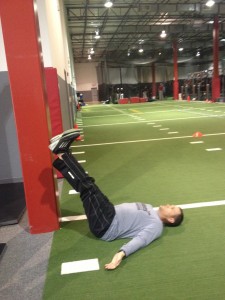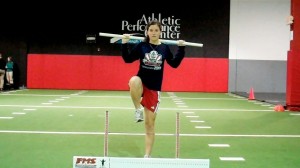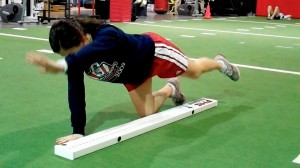Brian Schiff’s Blog
Injury Prevention, Sports Rehab & Performance Training Expert
This is the fourth corrective exercise I have featured in my “Functionally Fit” online column for Personal Fitness Professional Magazine. All of the correctives are based on screening assessments from the FMS.
The active straight leg raise (ASLR) assessment (as part of the FMS) is an essential part of any assessment I do on my athletes and runners. It provides a great look at a client’s ability to stabilize their spine/pelvis and we observe hip separation with one hip moving into flexion and the other fixed hip moving into greater relative extension.
Why does hip disassociation matter? Simply put, a lack of ideal separation can negatively impact step and/or stride length, reduce propulsion and create other compensations that increase energy expenditure and reduce overall running form. Some deviations that may occur include hip drop, increased rotation or circumduction of the swing leg, excessive torso rotation, increased knee flexion and diminished stride length to name a few.

Execution: Lie on your back. Using a doorway, place one leg against the doorway in a position that allows you to keep the lumbar spine flat while the other leg is extended and on the floor. Next, flex the down hip to the height of the other fixed leg extending the knees. This leg will remain unsupported. Now, point the toes of the unsupported leg and reach out toward the ceiling. Slowly lower the leg to the floor or the lowest point where you can still maintain a neutral lumbar spine (a bolster may be placed beneath the leg if needed). Perform 10 repetitions and repeat 2-3 sets on each side.
Progress the activity by lowering the leg further and/or sliding closer to the doorway to increase the hip flexion and total hip separation. Do not allow the lumbar spine to extend as this is a common compensatory motion for limited mobility in the iliopsoas.


Application: This activity will improve active mobility of flexed hip as well as promote continuous core stability and available hip extension of the opposite hip. It challenges the client’s ability to disassociate the lower extremities while maintaining stability in the pelvis and core. Keep in mind it is more than just a hamstring flexibility activity as it also addresses static (pelvis/spine) and dynamic (hip) stability in asymmetrical hip separation pattern.
This separation pattern is essential for optimal running mechanics. Poor hip disassociation can lead to asymmetrical or bilateral movement flaws, thereby reducing performance and leading to compensatory motion with an elevated risk for injury. This simple technique can be done daily to enhance hip mobility and pelvic/hip stability.
The FMS is a great tool to uncover asymmetry and movement dysfunction in fitness clients as well as patients in the clinic who are ready to transition back to sport. I have been using this tool consistently for 2.5 years in my practice. One of the questions I have asked myself about the screening tool is how reliable is it?

Click here for an earlier post I wrote on this topic regarding what it tells us as practitioners. One of the challenges with any screen or test is not only validity but reliability. In the April edition of the Journal of Strength and Conditioning Research, we gain some new insight regarding intra and interrater reliability via 2 new articles.
The first article discusses a controlled laboratory study where repeated measures were used to investigate how experience using the FMS and clinical experience as an athletic trainer (AT) affects the intrarater reliability of FMS testing. The raters (17 men and 21 women who were recruited from the university’s athletic training clinical staff and academic programs), with different levels of FMS and clinical experience (AT students, AT or AT with at least 6 months experience using the FMS) viewed each of the 3 videotaped models.
None of the AT students or AT members had seen or used the FMS previously compared to the AT group with at least 6 months of experience. Each group rated the models on each of the FMS exercises according to the script presented by the lead investigator. A week later the raters watched the same videos again in a different randomized order and rated each model on each exercise.
The intersession scores were examined to establish intrarater reliability of all participants. In addition, the intrarater reliability of different groups of participants (students and clinicians) was compared to infer differences about the influence of clinical experience as an AT along with previous experience using the FMS.
Results:
- Average FMS score was 13.68 +/- 0.98
- There was moderate intrarater reliability was observed when all participants were analyzed
- The AT group with experience had the strongest intrarater reliability followed by the AT group (no experience)
- The AT students demonstrated poor reliability with a large 95% confidence interval
Key takeaways:
- Previous research by Minick et al. had established excellent agreement on all components of the FMS among expert and novice raters indicating strong interrater reliability, but authors point out that is first study to look at intrarater reliability
- This helps establish reliability of assessment giving more credibility to using it as an effective assessment tool
- All raters were either AT’s or AT senior undergraduate students – need to include other professionals in future studies to confidently apply the external validity of the results in this particular study
- Primary limitation of this study is the fact that video was used as opposed to live assessment
- Possessing clinical experience and experience with the FMS strengthens intrarater reliability so learning to use the tool with other experienced clinicians may be wise to improve validity
Over the past several years, the trend in the health and fitness industry has been toward injury prevention and movement screening. Gray Cook and Lee Burton have given us the FMS. More recently, the Y-Balance test has emerged as another tool to assess asymmetry in the upper and lower quarter.
I am currently FMS certified and planning to attend the SFMA course next month in Durham. I routinely incorporate the FMS in both our rehab and sports performance work at the APC. I like many things about the screening exam. It provides a consistent tool to assess baseline movement and record asymmetry on a simple 4 point scale scale. It also has been shown to have good intra and inter-rater reliability. Click here for a recent study published in the Journal or Orthopaedic & Sports Physical Therapy.
For those unfamiliar with the screen, it is 7 tests scored on a 0-3 scale as follows:
- 0 = pain
- 1 = unable to perform the movement pattern (or perform with marked dysfunction)
- 2 = performs the movement with a mild compensation
- 3 = performs the movement correctly
I would say on average, most of the athletes I screen score between a 12 and 15. My highest score was a 19 (9 year old gymnast) and my lowest was a 9 (NFL lineman). As screeners, we are charged with uncovering asymmetry and faulty movement patterns. What do you see in the following picture?

Clearly, the dowel is not level, thus we score it a 2. She also had some ER in the right leg when stepping over the hurdle. She was a symmetrical 2 on the hurdle step test. This is a Division I soccer player who scored 17 on the exam.
Most of the movements seem straightforward. However, many question what the rotary stability test measures with respect to the ideal 3 score (ipsilateral movement)? It assesses an unnatural movement pattern to be sure. This athlete failed miserably on the ipsilateral pattern but scored a solid 2 with the contralateral pattern.

I have yet to test someone who can score a legitimate 3. I have seen some get a 3 on one side and 2 on the other (asymmetrical and a red flag in FMS land). As one who naturally questions things, I find myself questioning how many are truly capable of scoring a 3.

